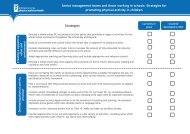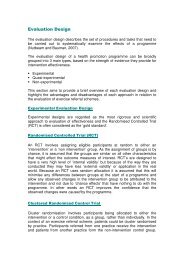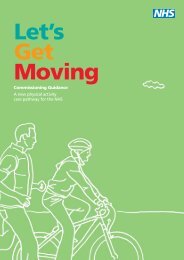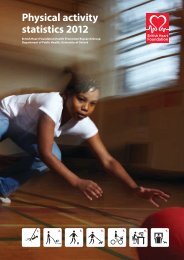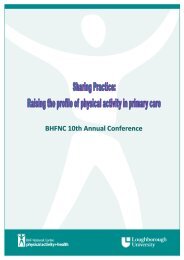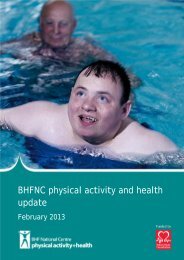Making the case for physical activity - BHF National Centre ...
Making the case for physical activity - BHF National Centre ...
Making the case for physical activity - BHF National Centre ...
Create successful ePaper yourself
Turn your PDF publications into a flip-book with our unique Google optimized e-Paper software.
Evidence Briefing1IntroductionPhysical in<strong>activity</strong> is known to be <strong>the</strong> fourth leadingcause of global mortality. Many of <strong>the</strong> leading causesof ill health in today’s society, such as coronaryheart disease, cancer and type 2 diabetes, couldbe prevented if more inactive people were tobecome active (1) . In <strong>the</strong> UK, <strong>the</strong> incidence ofnon-communicable disease which can be attributedto <strong>physical</strong> in<strong>activity</strong> includes:• 10.5% of coronary heart disease <strong>case</strong>s• 18.7% of colon cancer <strong>case</strong>s• 17.9% of breast cancer <strong>case</strong>s• 13.0% of type 2 diabetes <strong>case</strong>s• 16.9% of premature all-cause mortality (2) .In addition to reducing premature death and <strong>the</strong>incidence of disease, participating in <strong>physical</strong> <strong>activity</strong>also has benefits <strong>for</strong> mental health, quality of life andwellbeing and maintaining independent living in olderage. It can also play a key role in reducing health andsocial inequalities (3) . As a result of this wide-reachingimpact, <strong>physical</strong> <strong>activity</strong> has been described as <strong>the</strong>‘best buy in public health’ (4) .Key term – Physical <strong>activity</strong>Physical <strong>activity</strong> is described as any bodymovement produced by <strong>the</strong> skeletal muscles thatresults in a substantial increase over restingenergy expenditure (9) . Examples of <strong>physical</strong><strong>activity</strong> include play, lifestyle activities such aswalking and cycling (active transport), sportand recreational activities, household choresand gardening.Key term – Physical in<strong>activity</strong>Physical in<strong>activity</strong> is described as doing no orvery little <strong>physical</strong> <strong>activity</strong> at work, at home,<strong>for</strong> transport or during discretionary time andnot reaching <strong>physical</strong> <strong>activity</strong> guidelines deemednecessary to benefit public health (10) .Physical in<strong>activity</strong> also has a significant burden onhealthcare costs and <strong>the</strong> economy. In 2006/2007,£900 million was spent in <strong>the</strong> UK on ill health relatedto <strong>physical</strong> in<strong>activity</strong> (5) . The cost owing to <strong>physical</strong>in<strong>activity</strong> <strong>for</strong> different diseases was:• £117 million (stroke)• £542 million (heart disease)• £65 million (colorectal cancer)• £54 million (breast cancer)• £158 million (type 2 diabetes) (5) .<strong>Making</strong> <strong>physical</strong> <strong>activity</strong> a priority



